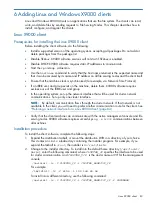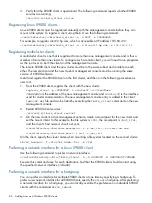
The Permissions Entry window has three permissions that are important to X9000 software: Read
Data, Write Data, and Execute File. These map directly to Read, Write, and Execute in the Linux
mode mask, as shown in the following table.
Windows permission
Linux permission
Read Data
Read
Write Data
Write
Execute
Execute
File creation, ownership, and administrative rights
Only the Windows root user (mapped to UID 0), a member of the root group (mapped to GID 0),
or the owner of a file can change the permissions assigned to a file or directory.
If a file or folder already has ACLs assigned on its native system (for example, Linux POSIX ACLs),
they cannot be changed on the other system. Only limited access is allowed; no ACL translation
is performed.
Because only mapped users can create files, all Windows users who will create files must be
mapped. Any Windows user not mapped to a Linux UID has read access to the file system but
cannot create files or directories.
The mode mask of a new file or directory is initialized as follows:
•
Owner is granted read-write-execute permissions.
•
Group and Other are granted read permission only if the file’s parent had read permission
for these classes of user. In addition, the execute permission is set on directories for Group
and Other.
A Linux-like permission schema can be implemented by setting a umask. The umask defines the
bits to clear in the target file mode mask. For example, a umask of 022 allows for an initial file
mode mask permission of
755—rwx
for owner and
rx
for group and other. An administrator can
restrict it by setting the umask to 077, which clears all bits in the file mode mask for group and
other. Setting the umask to 000 allows the maximum permission of 766 for files and 777 for
directories.
The mode mask of a file or directory is initialized to 766 or 777, respectively, and then adjusted
to the umask.
In the absence of a umask, the mode mask is initialized according to the schema described above.
Uninstalling X9000 clients
Uninstalling Linux X9000 clients
IMPORTANT:
Be sure to unmount the file system from X9000 clients before uninstalling the clients.
To uninstall a client, complete the following steps:
1.
On each X9000 client, run the following command to unmount the file system:
<installdirectory>/bin/ibrix_lwumount -f <fsname>
You can also use the management console GUI to perform the unmount.
2.
On the active management console, delete the X9000 clients from the configuration database:
<installdirectory>/bin/ibrix_client -d -h <CLIENTLIST>
3.
On each X9000 client, change to the installer directory and run the following command:
./ibrixinit -tc -U
94
Adding Linux and Windows X9000 clients
















































